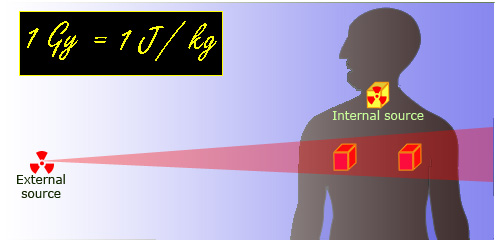Gray or Gy : unit of energy deposited in matter by radiation
The ‘absorbed dose’ is defined as the energy that radiations deposited locally in matter. As radioactive sources usually emit radiation evenly in all directions, a large percentage of this energy gets absorbed before reaching a given sample of matter by the air, by protective screens, or by other substances that happen to be in the way. The total energy deposited in the sample depends on all these geometric factors and the various absorptions. In principle, the energy dose can be calculated from the activity of the source, the energy of the radiation it emits by taking into account these geometrical and absorption factors. This calculation can be very difficult, and dosimeters are used in practice to come up with values.

A local energy deposit by radiation
In radioprotection and medicine, the amount of energy deposited by radiation in sensitive tissues or organs is primordial. For instance, in a pulmonary radiotherapy, energy deposited locally by the rays in the lungs would be considered. The source of radiation may also be internal : atoms of radioactive iodine fixed on thyroid following a scintigraphy or an accidental ingestion. The significant dose is the local energy deposited in this gland. The unit dose, the gray is equivalent to 1 Joule of energy absorbed per kilogram of matter.
© IN2P3
The energy of radiation can vary tremendously from one type of source to another: the beta electrons emitted by tritium have energies in the thousands of electronvolts, whereas the alpha particles that are expelled by polonium 212 have energies of 8.8 million electronvolts. Alpha and beta particles usually transfer all of their energy to the medium which directly surrounds the source. Gamma particles, however, can deposit their energy over a much larger volume. Individually, they can interact with matter through processes (photoelectric and Compton effects) that allow them to deposit energy. They can also go through the material without interacting, in which case they deposit no energy.
The basic unit of dose is the gray (Gy), which corresponds to one joule deposited per kilogram of matter. In terms of energy this is a tiny value, as it would take over 4000 grays to raise the temperature of water by 1 degree C. The important point to bear in mind, however, is that this energy is not spread over the whole volume but rather deposited in a very localised area, concentrated around the radiation path.
In the heart of reactors or particle accelerators, substances are exposed to very high levels of radiation which can lead to the deterioration of their physical or mechanical properties.
For living matter, the gray is of the right order of magnitude to deal with short or intense exposure. A lung X-ray, for instance, leaves a dose of 1 milligray. In intensive radiotherapy, however, the body is exposed to a dose of 50 grays – which leads to massive destruction of cells but in a highly localized area.
Other articles on the subject « Radioactive Doses »
Radioactive Activity Doses
Becquerel or Bq : the activity unit of a radioactive source The activity of a sample of matter wh[...]
Biological doses
Sievert (Sv) : the unit of doses for the living The energy deposited in a living organism by radi[...]
Equivalent Dose
A local biological dose The concept of the « equivalent dose » which takes into account the natur[...]
Effective Dose
A full-body dose, central in the field of radioprotection The « effective dose » is a biological [...]
MilliSievert
A unit for low doses of radioactivity After a nuclear accident or accident of radioactivity, it i[...]
Dose Scale
A dose classification for acute exposures When dealing with exposure to radiations, what do we me[...]